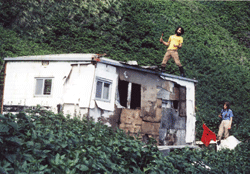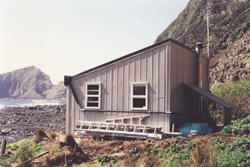|
|
|
 |
|
|
|
History of Scientific Research on Triangle Island
|
|
|
|
|
|
|
|
Following up on surveys by researchers from the British Columbia Museum in the 1950s, in the 1970s the Canadian Wildlife Service began integrated studies of Triangle Island's seabirds. This research was led initially by CWS Research Scientist Kees Vermeer, who conducted pioneering studies of seabird breeding biology on Triangle. |
|
|
|
 |
|
|
|
Later, in the 1980s, CWS biologists Gary Kaiser, Michael Rodway and Moira Lemon led field crews that carried out the enormously difficult task of determining the size of Triangle's seabird populations (in fact, they estimated the size of seabird populations in the entire province!). |
|
|
| The first field station on Triangle, circa 1985 (Michael Rodway and Moira Lemon) |
|
|
| These studies, along with those of University of British Columbia PhD student Anne Vallée and Simon Fraser University MSc student Doug Bertram in the 1980s, provided a critical baseline of information against which results of research later carried out by the Centre for Wildlife Ecology can be compared. |
|
| The existence of this baseline was one of the main reasons why, in 1994, the CWE's Fred Cooke and Ian Jones selected Triangle Island as the site at which to establish a long-term seabird research and monitoring program. Following Ian's departure in 1995 to a research chair position at Memorial University with the Atlantic Cooperative Wildlife Ecology Research Network (the Atlantic counterpart to the CWE), Doug Bertram returned to lead the Triangle Island program. |
|
 |
|
|
| The 2nd field station on Triangle, built in 1994 |
|
| When Doug left in 2001 to head up the Marbled Murrelet Recovery Team as a biologist with the Canadian Wildlife Service, Mark Hipfner became Scientific Director of the Triangle program. |
|
|
|
|
|
|
|
|
|
|
|
|
|
|
|


